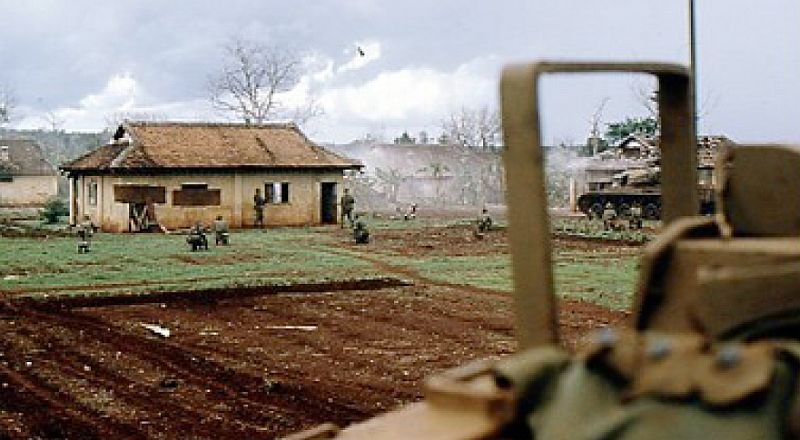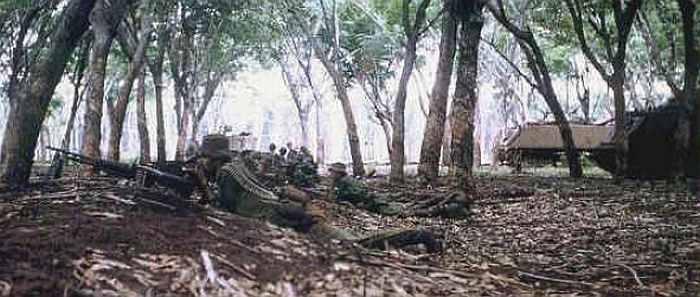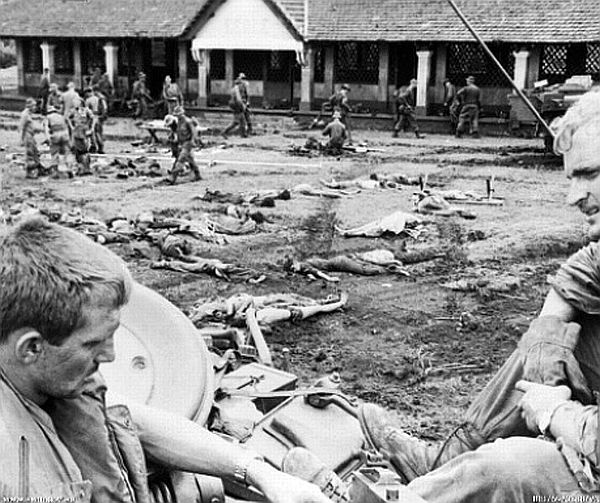P
PoorOldSpike
Guest
Aussies v Charlie,
The Battle of Binh Ba
6 June 1969

Armour in action at Binh Ba
In the years following the establishment of the Australian Task Force base at Nui Dat, the nearby village of Binh Ba was subject to several cordon and search operations but the insurgents continued to return to, and operate from the village. Living on Route 2, a major road that ran from Phuoc Tuy’s capital Ba Ria northwards into the neighbouring province, Binh Ba’s residents were accustomed to seeing military traffic passing through their village.
On an early June morning in 1969 two Australian Centurion Tanks were making their way northwards along Route 2 when they came under fire from a nearby house. The shot, believed by some to have been fired by a nervous soldier and by others to have been a deliberate provocation, had its effect. Within hours an Australian force sat just beyond Binh Ba awaiting the order to go in and clear the village. Ahead of them lay a battle of unexpected ferocity in a setting unlike almost any other experienced by the Australians in Vietnam.

Main road to Binh Ba
Less than 10 kilometres from Nui Dat, the village of Binh Ba and its hamlets—Duc Trung and Duc My—had been familiar to the Australians since the Task Force base was established in 1966. In August that year the village was the target of a cordon and search operation, Operation Holsworthy, in which the Australians apprehended a number of Viet Cong (VC) guerrillas and sympathisers. But Binh Ba’s proximity to Nui Dat did not ensure its continuing freedom from insurgents. Within two months a VC cadre and guerrillas were once again in residence, collecting taxes and recruiting. Cordon and search operations such as Holsworthy and Operation Caloundra, in early 1967, were fleeting. When they were over, the insurgents returned. In late 1967 they ambushed and killed two members of the Australian Army Training Team Vietnam just outside the village. Their activities were mostly covert, though. One VC soldier recalled his unit being divided into cells of a few men each and sent on a ‘proselytising mission’ to Binh Ba, during which they met their local counterparts in various village houses.
The situation persisted into the middle of 1969, by which time Binh Ba’s security had been placed in the hands of local Regional Force soldiers. Neither the Task Force nor the South Vietnamese forces which had day-to-day responsibility for the village’s security had been able to rid the area of insurgents. That June morning, with one RPG round, they compelled the Australians to fight for Binh Ba. There are a range of reasons why the battle was initiated. Some believe that it was an attempt to relieve pressure being put on the North Vietnamese Army’s (NVA) 33 Regiment headquarters in the area to the north where 6RAR were operating. Others believe that it was part of a nation-wide offensive aimed at influencing peace negotiations which were then taking place in Paris; still others saw it as an attempt to gain credit for the soon to be announced withdrawal of some 25,000 United States troops from Vietnam. 5RAR’s Commanding Officer Lieutenant Colonel Colin Khan, who commanded the Australian force for much of the battle, believed then and continued to believe more than 30 years later that the attack on the Centurion was nothing more than the result of poor fire discipline by a ‘wayward soldier’.
After the Centurion was hit, two Regional Force platoonswere sent to investigate but were stopped by heavy fire from the village. The district chief requested support from provincial headquarters in Ba Ria, which in turn requested Australian assistance. Less than an hour later, Major Murray Blake, the officer commanding the Task Force’s ready reaction force—D Company, 5RAR—attended a briefing at the Task Force headquarters. His orders were to mount a clearing operation of the village. Expecting to meet a couple of Viet Cong platoons, Blake told his company sergeant major that ‘there didn’t seem to be too much in this’. He elected to bring six newly arrived reinforcements along for the experience.

Waiting to move off
The battle begins
At 10:00 am Blake’s company left Nui Dat in armoured personnel carriers (APCs) commanded by Captain Ray De Vere of B Squadron, 3 Cavalry Regiment. With them was a composite troop of tanks from B Squadron, 1st Armoured Regiment, under the command of Second Lieutenant Brian Sullivan. While the Australians travelled the short distance between Nui Dat and Binh Ba, the local District Chief attempted to evacuate the civilian population and deployed his own troops, members of the Regional Force, into blocking positions to cut off the enemy’s escape.
Half an hour after leaving Nui Dat, Blake’s force deployed about 300 metres to the south-east of Binh Ba and awaited clearance to move in. Sergeant Brian London, 10 Platoon’s acting commander, remembered pulling up on open ground before the village. Looking through the APC’s open hatch he saw thirty or forty people running as if to make up a defensive position’. Seconds later RPG smoke trails headed towards him. Instinct demanded that he exit the APC—a hit from an RPG could have killed or wounded everyone on board—but he fought the urge and stayed. The armoured vehicles were just outside effective RPG range and their crews were already returning fire—the Battle of Binh Ba, known officially as Operation Hammer, was underway. Blake, meanwhile, was concentrating on the flurry of radio traffic coming through on about eight networks. The airwaves
were busy with talk about who was in the village. Civilians, it turned out, remained and Blake instructed his men to take care and make sure their fire was aimed only at the enemy. It was, he said, a ‘big ask’ in a combat situation. He had also to consider how best to carry out the attack. Numbers were limited: D Company was badly depleted, with only seventy men from a normally full complement of 120 available. Between them Blake, De Vere and Sullivan decided on an armoured assault, believing that dismounted infantry would be too vulnerable to enemy fire. De Vere, the senior armoured officer, took command during this phase of the operation. By 11:20 the Australians were cleared to move in. The District Chief, wrongly believing the village to be free of civilians, told Blake, to ‘go in and do what you have to do.’ Binh Ba, a picturesque village with a well-ordered streetscape, solidly constructed houses and verdant, productive gardens would, he knew, soon become a battle ground. Approaching from the east the Australians advanced with tanks in the centre of the formation and the APCs on either side and to the rear. As they entered Binh Ba it became clear that not all of the civilians had been evacuated, so 11 Platoon was ordered to dismount and help the villagers to safety.
The Battle of Binh Ba
6 June 1969

Armour in action at Binh Ba
In the years following the establishment of the Australian Task Force base at Nui Dat, the nearby village of Binh Ba was subject to several cordon and search operations but the insurgents continued to return to, and operate from the village. Living on Route 2, a major road that ran from Phuoc Tuy’s capital Ba Ria northwards into the neighbouring province, Binh Ba’s residents were accustomed to seeing military traffic passing through their village.
On an early June morning in 1969 two Australian Centurion Tanks were making their way northwards along Route 2 when they came under fire from a nearby house. The shot, believed by some to have been fired by a nervous soldier and by others to have been a deliberate provocation, had its effect. Within hours an Australian force sat just beyond Binh Ba awaiting the order to go in and clear the village. Ahead of them lay a battle of unexpected ferocity in a setting unlike almost any other experienced by the Australians in Vietnam.

Main road to Binh Ba
Less than 10 kilometres from Nui Dat, the village of Binh Ba and its hamlets—Duc Trung and Duc My—had been familiar to the Australians since the Task Force base was established in 1966. In August that year the village was the target of a cordon and search operation, Operation Holsworthy, in which the Australians apprehended a number of Viet Cong (VC) guerrillas and sympathisers. But Binh Ba’s proximity to Nui Dat did not ensure its continuing freedom from insurgents. Within two months a VC cadre and guerrillas were once again in residence, collecting taxes and recruiting. Cordon and search operations such as Holsworthy and Operation Caloundra, in early 1967, were fleeting. When they were over, the insurgents returned. In late 1967 they ambushed and killed two members of the Australian Army Training Team Vietnam just outside the village. Their activities were mostly covert, though. One VC soldier recalled his unit being divided into cells of a few men each and sent on a ‘proselytising mission’ to Binh Ba, during which they met their local counterparts in various village houses.
The situation persisted into the middle of 1969, by which time Binh Ba’s security had been placed in the hands of local Regional Force soldiers. Neither the Task Force nor the South Vietnamese forces which had day-to-day responsibility for the village’s security had been able to rid the area of insurgents. That June morning, with one RPG round, they compelled the Australians to fight for Binh Ba. There are a range of reasons why the battle was initiated. Some believe that it was an attempt to relieve pressure being put on the North Vietnamese Army’s (NVA) 33 Regiment headquarters in the area to the north where 6RAR were operating. Others believe that it was part of a nation-wide offensive aimed at influencing peace negotiations which were then taking place in Paris; still others saw it as an attempt to gain credit for the soon to be announced withdrawal of some 25,000 United States troops from Vietnam. 5RAR’s Commanding Officer Lieutenant Colonel Colin Khan, who commanded the Australian force for much of the battle, believed then and continued to believe more than 30 years later that the attack on the Centurion was nothing more than the result of poor fire discipline by a ‘wayward soldier’.
After the Centurion was hit, two Regional Force platoonswere sent to investigate but were stopped by heavy fire from the village. The district chief requested support from provincial headquarters in Ba Ria, which in turn requested Australian assistance. Less than an hour later, Major Murray Blake, the officer commanding the Task Force’s ready reaction force—D Company, 5RAR—attended a briefing at the Task Force headquarters. His orders were to mount a clearing operation of the village. Expecting to meet a couple of Viet Cong platoons, Blake told his company sergeant major that ‘there didn’t seem to be too much in this’. He elected to bring six newly arrived reinforcements along for the experience.

Waiting to move off
The battle begins
At 10:00 am Blake’s company left Nui Dat in armoured personnel carriers (APCs) commanded by Captain Ray De Vere of B Squadron, 3 Cavalry Regiment. With them was a composite troop of tanks from B Squadron, 1st Armoured Regiment, under the command of Second Lieutenant Brian Sullivan. While the Australians travelled the short distance between Nui Dat and Binh Ba, the local District Chief attempted to evacuate the civilian population and deployed his own troops, members of the Regional Force, into blocking positions to cut off the enemy’s escape.
Half an hour after leaving Nui Dat, Blake’s force deployed about 300 metres to the south-east of Binh Ba and awaited clearance to move in. Sergeant Brian London, 10 Platoon’s acting commander, remembered pulling up on open ground before the village. Looking through the APC’s open hatch he saw thirty or forty people running as if to make up a defensive position’. Seconds later RPG smoke trails headed towards him. Instinct demanded that he exit the APC—a hit from an RPG could have killed or wounded everyone on board—but he fought the urge and stayed. The armoured vehicles were just outside effective RPG range and their crews were already returning fire—the Battle of Binh Ba, known officially as Operation Hammer, was underway. Blake, meanwhile, was concentrating on the flurry of radio traffic coming through on about eight networks. The airwaves
were busy with talk about who was in the village. Civilians, it turned out, remained and Blake instructed his men to take care and make sure their fire was aimed only at the enemy. It was, he said, a ‘big ask’ in a combat situation. He had also to consider how best to carry out the attack. Numbers were limited: D Company was badly depleted, with only seventy men from a normally full complement of 120 available. Between them Blake, De Vere and Sullivan decided on an armoured assault, believing that dismounted infantry would be too vulnerable to enemy fire. De Vere, the senior armoured officer, took command during this phase of the operation. By 11:20 the Australians were cleared to move in. The District Chief, wrongly believing the village to be free of civilians, told Blake, to ‘go in and do what you have to do.’ Binh Ba, a picturesque village with a well-ordered streetscape, solidly constructed houses and verdant, productive gardens would, he knew, soon become a battle ground. Approaching from the east the Australians advanced with tanks in the centre of the formation and the APCs on either side and to the rear. As they entered Binh Ba it became clear that not all of the civilians had been evacuated, so 11 Platoon was ordered to dismount and help the villagers to safety.
Last edited by a moderator:







































